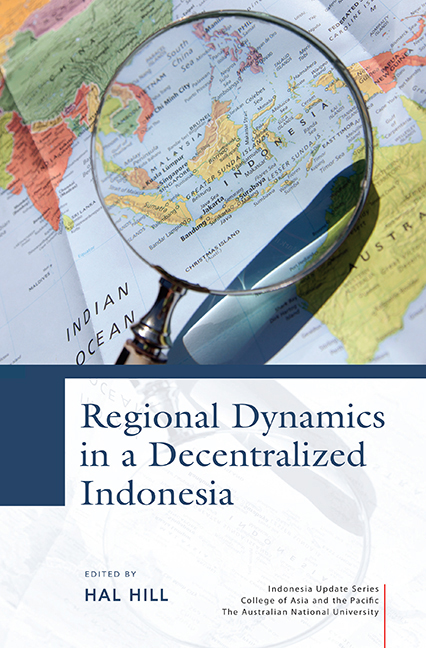Book contents
- Frontmatter
- Dedication
- Contents
- Tables
- Figures
- Contributors
- Acknowledgments
- Glossary
- Map of Indonesia
- 1 An introduction to the issues
- PART 1 HISTORICAL, ECONOMIC, POLITICAL AND SOCIAL PATTERNS
- 2 Before the ‘big bang’: decentralization debates and practice in Indonesia, 1949–99
- 3 Indonesia's decentralization: the rise of local identities and the survival of the nation-state
- 4 Hares and tortoises: regional development dynamics in Indonesia
- 5 Patterns of regional poverty in the new Indonesia
- PART 2 DECENTRALIZATION AND GOVERNANCE
- PART 3 LOCAL-LEVEL PERSPECTIVES
- PART 4 MIGRATION, CITIES AND CONNECTIVITY
- PART 5 CHALLENGES FOR INDONESIA'S PERIPHERY
- Author index
- Subject index
- INDONESIA UPDATE SERIES
4 - Hares and tortoises: regional development dynamics in Indonesia
from PART 1 - HISTORICAL, ECONOMIC, POLITICAL AND SOCIAL PATTERNS
Published online by Cambridge University Press: 21 October 2015
- Frontmatter
- Dedication
- Contents
- Tables
- Figures
- Contributors
- Acknowledgments
- Glossary
- Map of Indonesia
- 1 An introduction to the issues
- PART 1 HISTORICAL, ECONOMIC, POLITICAL AND SOCIAL PATTERNS
- 2 Before the ‘big bang’: decentralization debates and practice in Indonesia, 1949–99
- 3 Indonesia's decentralization: the rise of local identities and the survival of the nation-state
- 4 Hares and tortoises: regional development dynamics in Indonesia
- 5 Patterns of regional poverty in the new Indonesia
- PART 2 DECENTRALIZATION AND GOVERNANCE
- PART 3 LOCAL-LEVEL PERSPECTIVES
- PART 4 MIGRATION, CITIES AND CONNECTIVITY
- PART 5 CHALLENGES FOR INDONESIA'S PERIPHERY
- Author index
- Subject index
- INDONESIA UPDATE SERIES
Summary
INTRODUCTION
This chapter examines regional development patterns in Indonesia since the 1970s. In earlier work (Hill, Resosudarmo and Vidyattama 2008; Vidyattama 2008) we concluded that, although inter-regional inequality was high, growth during the period 1975–2005 was spatially quite broadly distributed. A very gradual convergence in provincial per capita income levels was discernible according to the two most widely used economic indicators (discussed below), suggesting some catch-up among the poorest regions. The precise magnitudes depended on which concept of inequality and which income series were used. Few provinces performed consistently poorly and, apart from the special cases related to conflict, very few grew significantly more slowly than the national average. Greater Jakarta became ever more dominant during the period. Together with East Kalimantan, it continued to be the richest province from the 1980s. In general, the better-performing regions were those that were more connected to the global economy, through commodity exports, tourism or the modern industrial–service economy.
However, the unit of analysis in our earlier work was confined to the provinces, as the district (kabupaten/kota) dataset was still in its infancy, covering a relatively short time span of about a decade. Moreover, we were able to draw only limited inferences about the effects of decentralization, both because the analysis was conducted at the provincial level and because the regional accounts data were then available only through to 2005. The purpose of this chapter is to extend this research in two directions. First, we pay greater attention to the district as the unit of analysis, consistent with the longer and better data series now available, and with the fact that districts have been the focus of the decentralization measures legislated in 1999 and implemented since 2001. Second, as we now have data for the decade since decentralization commenced, we are able to examine the effects of these reforms on regional development outcomes.
The chapter is organized as follows. In section 4.2 we provide a broad overview of regional development dynamics, among the major island groupings and at the provincial level, extending and updating our earlier research. We also examine the correlations between economic and social indicators, and trends in inequality. Section 4.3 repeats this analysis at the district level, examining in particular whether the broad regional mosaic at the provincial level holds at the more disaggregated district level of analysis.
- Type
- Chapter
- Information
- Regional Dynamics in a Decentralized Indonesia , pp. 68 - 97Publisher: ISEAS–Yusof Ishak InstitutePrint publication year: 2014

